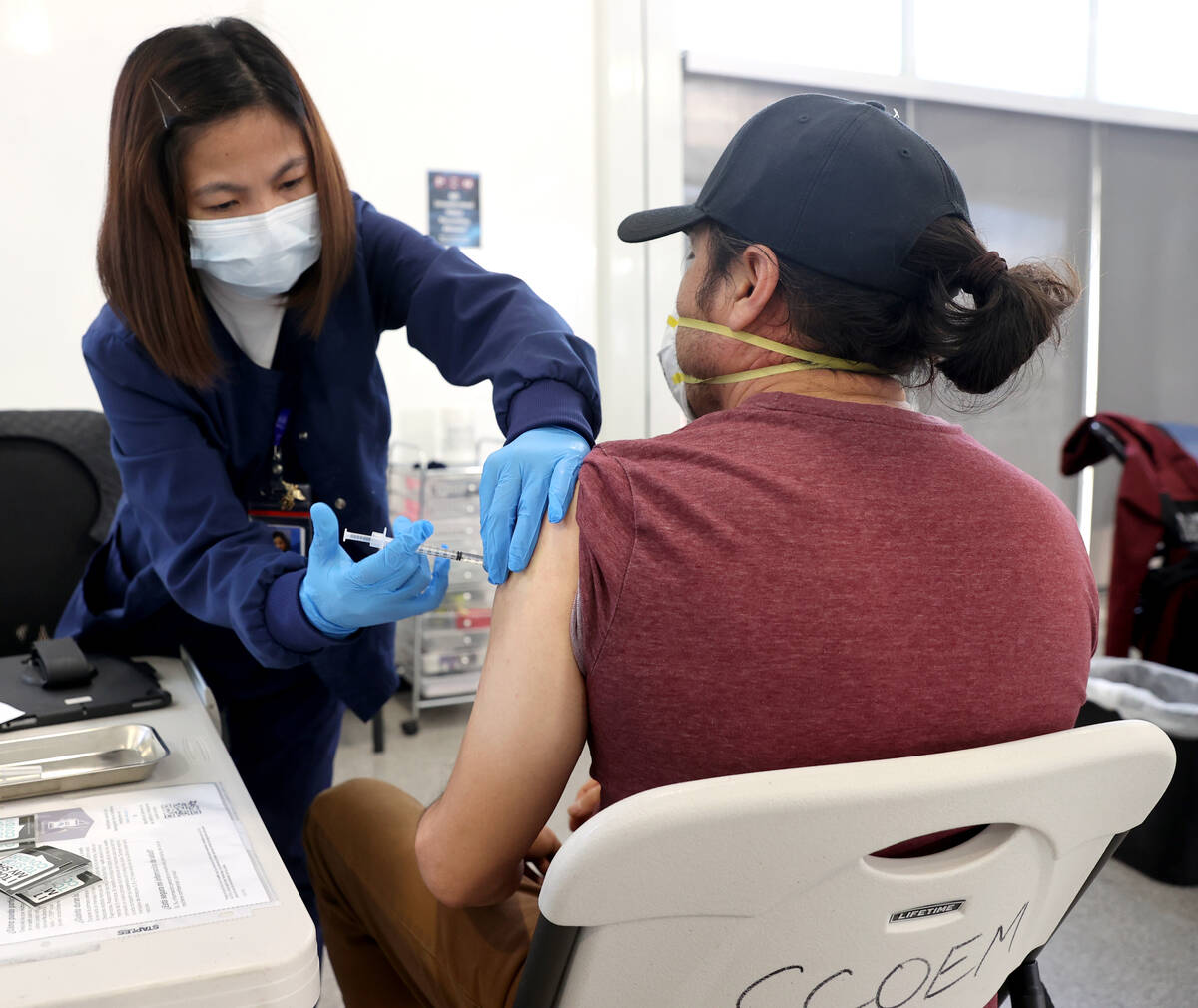Fresh wave of COVID hits Southern Nevada, but no new deaths in Nye County
A fresh wave of COVID-19 infections has hit Southern Nevada, triggered by a new omicron subvariant, waning immunity and riskier behavior, a top official with the Southern Nevada Health District said Wednesday.
Like much of the country, Southern Nevada is seeing increases in new reported coronavirus cases, said Cassius Lockett, the district’s director of disease surveillance and control. Reported cases represent an undercount of infections, since many people now are testing for the virus using at-home rapid tests, their results going unreported.
“I think we should be concerned, simply because it (COVID-19) is undercounted, it’s spreading quickly in the community, and we’re going to see more uptick in cases,” he said.
New omicron subvariant BA.2.12.1, believed to be better at evading immunity from natural infection and vaccination, is on the rise in Clark County, Lockett said. What’s more, this built-up immunity wanes over time. Add to the mix that people have let down their guard against the virus and are engaging in riskier behaviors.
After cases plummeted in February and early March, they began to tick up again in late March.
Nevada’s state health response team, which has canceled the regular briefings held throughout most of the pandemic, said in the release that cases are “expected to rise through May.”
It’s unknown how big the current wave will become, and what impact it will have on hospitals and the community, said Lockett, who is recovering from what he described as a moderate case of COVID-19.
No new deaths in Nye County
Nye County recorded no new deaths from the virus in the past two weeks, according to county officials, who said Wednesday that they will be closing the Pahrump vaccine clinic that has provided free vaccinations and boosters to the community during the pandemic. The clinic will administer its final vaccinations from 9 a.m. to 11 a.m. on Tuesday, May 17 at the community health nurse’s office, 1981 E. Calvada Blvd.
Flags will be flown at half-staff at all Nye County and town of Pahrump offices, facilities and parks until sunset Monday to commemorate the county’s 241 COVID-related deaths since the initial outbreak in March 2020.
‘Pockets of devastation’ expected
In late March, the Nevada State Public Health Laboratory began to detect the presence of BA.2.12.1 in the state, an omicron subvariant with a mutation on its spike protein believed to help it evade immunity to the virus, said Andrew Gorzalski, the lab’s molecular supervisor. The lab analyzes the genetic makeup of a sampling of positive COVID-19 test specimens from across the state.
The subvariant’s growing presence coincides with an increase in COVID-19 cases across the state as well as increasing levels of the virus in waste water, Gorzalski said. Waste water surveillance, which analyzes coronavirus shed from the body in feces, serves as an early warning system for spikes in infections.
As the current levels of virus in waste water approach those detected during last summer’s delta surge, “I think there’s reason to be alarmed at the levels at this point,” he said.
Dan Gerrity, a microbiologist who monitors coronavirus levels in waste water in Southern Nevada, said that current levels generally are two or three times higher than they were a month ago, but have not reached the levels of the alpha or delta surges, and are well below omicron surge levels.
Based on case counts and waste water data, “I would not be surprised at all to see a small wave in Nevada,” said Julie Swann, a professor at North Carolina State University.
“I think it’s going to be more of a ripple than a huge wave,” said Swann, an adviser to the Centers for Disease Control and Prevention who studies COVID-19 disease trends.
“I’m not at all ringing the warning bells that I was ringing in December of ’21,” as the omicron variant was beginning to spread, she said.
However, some groups will be more affected by the wave than others, including the minority of the population that has not been infected with COVID-19, those who are unvaccinated, and people with underlying health conditions, Swann said.
“I think there are going to be pockets of devastation,” she said, based on the susceptibility of individuals in a particular household or community, or of those attending a particular event.
More mandates?
Despite the increases, Lockett said that the health district is not recommending reimposing a mask mandate. No discussions are underway “at the moment” about reimplementing any pandemic restrictions.
“When that’s done, it will be done in coordination with our state partners,” he said.
Under Nevada’s indoor mask mandate, which Gov. Steve Sisolak rescinded in February, masks were required in counties with higher rates of transmission, as defined by the CDC. With a 15 percent test positivity rate, Clark County would again be under a mask mandate if the CDC’s criteria were applied today.
Brian Labus, an epidemiologist and assistant professor at UNLV’s School of Public Health, emphasized that despite the increasing numbers of cases, they remain comparatively low.
This is because much of the population continues to have some level of immunity to the virus, in part because so many people became infected during the winter’s omicron wave, he said.
The Centers for Disease Control and Prevention recently said that 60 percent of the population had been infected by the coronavirus as of February, twice the number as in December.
“There are so many people that are immune right now that it’s hard for the disease to kind of explode,” Labus said.
“We won’t see the same massive surges as we’ve seen in the past,” he predicted for the near future. “We will see increases but it’s not like something that’s going to completely overwhelm our community.”
Brent Schanding contributed to this report.













